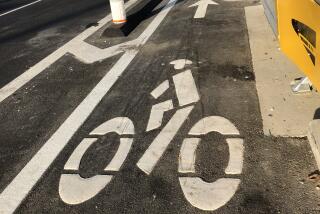It’s Not Pretty but It’s Safe, Tinkerer Says
- Share via
Inside Tad Winiecki’s garage, deep in Tierrasanta, may lie the answer to safer motorcycles. Then again, it’s just as possible that the experimental motorbike housed there may end up a novelty, a curiosity piece set amid garage clutter like the washing machine and dryer.
Such is the fate of backyard inventors and garage tinkerers like Winiecki. Driven by big dreams, they labor in obscurity, hopeful for the one break that will thrust their creations into the public market. But the wait for fame and fortune can be long, so in the meantime the 43-year-old Winiecki is having a lot of fun.
Never mind that Winiecki rides with the Gospel Riders, the San Diego chapter of the Christian Motorcyclists Assn.; there seems to be a constant impish grin etched on his face. All the better to greet the curious who stare at him while he rides his strange-looking vehicle, which he has dubbed the Safercycle, along the city’s streets.
Looking something like a bobsled on rubber wheels crossed with a torpedo, the Safercycle is 700 pounds of special doors, springs, shock absorbers, pulleys, a roll bar and more. There is an anti-somersault front end. The padded side doors also serve as side stands to keep the vehicle upright. And the handlebars fold on impact.
Winiecki also has developed a special restraint system that attaches to the motorcycle’s bucket seat to hold the rider in as securely as if he were strapping himself into the cockpit of an F-16 fighter jet. The front is surrounded by a streamlined, fiber glass fairing.
“I had a mechanical failure a little bit ago and hit another car. Now, that was embarrassing,” Winiecki said of the fender bender.
His love affair with motorcycles dates to his days as a kid in Washington state, when he first took to the road on an Indian Warrior motorbike.
Since then, Winiecki has earned a college degree in physics and a master’s degree in space science. When he was an engineer for Bendix, he worked on the Skylab and Apollo space projects, as well as in the National Highway Traffic Safety Administration’s research on crash bars and air bags in cars.
“I learned a few things about protecting people . . . and that got me interested in building a safe motorcycle,” Winiecki said, noting that his job as a research engineer often ended up in glorified paper shuffling and frustration.
So in 1979, he launched a concerted effort to create a crash-safe motorcycle, tailored for people who are afraid to ride motorcycles because they might get hurt.
Thus was born the Safercycle, a Winiecki creation covered by four U.S. patents.
There is only one Safercycle, an engineering model built from the frame of a 1976 BMW R90S. The motorbike is particularly smooth to ride at speeds of more than 30 miles per hour, and Winiecki says it takes about 15 seconds to get on the vehicle, strap in and drive away.
Many of Winiecki’s theories about the motorcycle’s safety are just that. With only one model, he can’t afford to put the motorbike through extensive crash tests. For that reason, Winiecki, now an engineer for General Dynamics Corp., tried to interest the federal government in testing his creation. But it turned him down.
“The government has conducted all kinds of safety tests on cars, and it crashed a four-engine jet into the desert to study airplane safety, but it has done nothing for motorcycle safety,” Winiecki says. “This administration isn’t interested in motorcycle safety.”
He hopes a motorcycle manufacturer might become interested in the Safercycle.
“There are all kinds of people who believe it’s dangerous to ride motorcycles or who won’t let their kids ride because they’re afraid of what might happen,” Winiecki said. “That’s a big market. I expect fewer than 2% of those who now own motorcycles would be interested in the Safercycle.
“What I’m trying to do is get a lot of publicity and build up a demand and then go to the manufacturers. They aren’t going to do anything unless there’s a market for it.”
Winiecki won’t say how much money he has poured into his Safercycle, though he has written a detailed analysis of its features, including a cost comparison with other forms of transportation. He has run a computer analysis testing the motorbike’s frame and hired an artist to draw pictures he uses in a slide show. At one point, he even did an elaborate crash test in his backyard to test the shock absorber part of the restraint system.
Using the steep canyon behind his house, Winiecki, with the help of friends, set up pilings at the top and near the bottom, and then connected them with a cable several feet above the ground.
To the cable he hooked a heavy piece of concrete carrying a shock-absorbing device. Winiecki released the concrete block, which headed downhill on a bee-line toward a collision with the pilings.
“Unfortunately,” he said, “I found out the tests were flawed,” although he didn’t elaborate.
Winiecki says that the Safercycle is a “level of effort project,” which means he puts as much time into it as he wants, which right now is about one day a week.
One gets the distinct feeling that if fame and fortune never make it to his door, Tadeus Carl Winiecki won’t be particularly upset.
“I’m still trying to refine the engineering model and make it look pretty,” he said. “If nothing ever happens, then I’ll have the only one, and I’ll ride around with my gang and get a lot of looks.”






